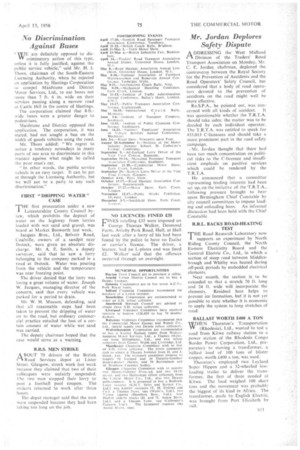Mr. Jordan Deplores Safety Dispute
Page 45

If you've noticed an error in this article please click here to report it so we can fix it.
DDRESSING the West Midland I-1 Division of the Traders' Road Transport Association on Monday, Mr. C. E. Jordan chart-man, deplored the controversy between the Royal Society for the Prevention of Accidents and the Road Operators' Safety Council, but considered that a body of road operators devoted to the prevention of• accidents on the road might well be more effective.
Ro.S.P.A., he pointed out, was con cerned with all kinds of accident. It was questionable whether the T.R.T.A. should take sides: the matter was to be decided by each individual operator. . The T.R.T.A. was entitled to speak for 455,013 C-licensees and should take a more prominent part in the road safety campaign.
Mr. Jordan thought that there had been too much concentration on political risks to the C-licensee and insufficient emphasis on positive services which could be rendered by the T.R.T.A.
He announced that a committee representing trading interests had been set up, on the initiative of the 'T.R.T.A., following pressure brought to bear upon Birmingham Chief Constable by city council committees to impose loading and unloading bans. An informal discussion had been held with the Chief Constable R.R.L. BACKS ROAD-HEATING
THE Road Research Laboratory now supports an experiment by North Riding County Council, the North Eastern Electricity Board and the General Electric Co.. Ltd., in which a section of steep road between Middlesbrough and Whitby was heated during off-peak periods by embedded electrical elements.
Next month, the section is to be extended so that a stretch 70 ft. long and 24 ft. wide will incorporate the elements. Residual heat helps to prevent ice formation, but it is not yet possible to state whether it is economic to apply the system to long stretches of road.
BALLAST WORTH £400 A TON yUgEN Thornton's Transportation " (Rhodesia), Lid., wanted to test a road from Kitwe railway station to a power station of the Rhodesia Congo Border Power Corporation, Ltd., preparatory to moving a transformer, a ballast load of 100 tons of blister copper, worth £400 aton, was used. Thornton's employed two Leyland Super Hippos and a 32-wheeled lowloading 'trailer to deliver the transformer, the first of three needed at Kitwe. The load weighed 100 short tons and the movement was probably the biggest of its kind in Africa. The transformer, made by English Electric, was .brought from Port Elizabeth bv rail




















































































































